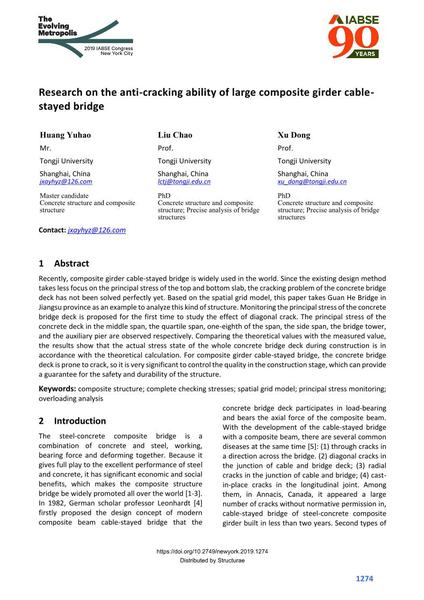Research on the anti-cracking ability of large composite girder cable- stayed bridge

|
|
|||||||||||
Bibliographic Details
| Author(s): |
Yuhao Huang
(Tongji University)
Liu Chao (Tongji University) Xu Dong (Tongji University) |
||||
|---|---|---|---|---|---|
| Medium: | conference paper | ||||
| Language(s): | English | ||||
| Conference: | IABSE Congress: The Evolving Metropolis, New York, NY, USA, 4-6 September 2019 | ||||
| Published in: | The Evolving Metropolis | ||||
|
|||||
| Page(s): | 1274-1281 | ||||
| Total no. of pages: | 8 | ||||
| DOI: | 10.2749/newyork.2019.1274 | ||||
| Abstract: |
Recently, composite girder cable-stayed bridge is widely used in the world. Since the existing design method takes less focus on the principal stress of the top and bottom slab, the cracking problem of the concrete bridge deck has not been solved perfectly yet. Based on the spatial grid model, this paper takes Guan He Bridge in Jiangsu province as an example to analyze this kind of structure. Monitoring the principal stress of the concrete bridge deck is proposed for the first time to study the effect of diagonal crack. The principal stress of the concrete deck in the middle span, the quartile span, one-eighth of the span, the side span, the bridge tower, and the auxiliary pier are observed respectively. Comparing the theoretical values with the measured value, the results show that the actual stress state of the whole concrete bridge deck during construction is in accordance with the theoretical calculation. For composite girder cable-stayed bridge, the concrete bridge deck is prone to crack, so it is very significant to control the quality in the construction stage, which can provide a guarantee for the safety and durability of the structure. |
||||
| Keywords: |
composite structure complete checking stresses spatial grid model principal stress monitoring overloading analysis
|
||||
